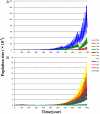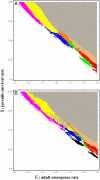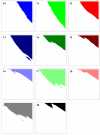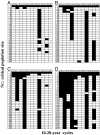Allee effect in the selection for prime-numbered cycles in periodical cicadas
- PMID:19451640
- PMCID: PMC2690011
- DOI: 10.1073/pnas.0900215106
Allee effect in the selection for prime-numbered cycles in periodical cicadas
Abstract
Periodical cicadas are well known for their prime-numbered life cycles (17 and 13 years) and their mass periodical emergences. The origination and persistence of prime-numbered cycles are explained by the hybridization hypothesis on the basis of their lower likelihood of hybridization with other cycles. Recently, we showed by using an integer-based numerical model that prime-numbered cycles are indeed selected for among 10- to 20-year cycles. Here, we develop a real-number-based model to investigate the factors affecting the selection of prime-numbered cycles. We include an Allee effect in our model, such that a critical population size is set as an extinction threshold. We compare the real-number models with and without the Allee effect. The results show that in the presence of an Allee effect, prime-numbered life cycles are most likely to persist and to be selected under a wide range of extinction thresholds.
Conflict of interest statement
The authors declare no conflict of interest.
Figures





Similar articles
- Evolution of periodicity in periodical cicadas.Ito H, Kakishima S, Uehara T, Morita S, Koyama T, Sota T, Cooley JR, Yoshimura J.Ito H, et al.Sci Rep. 2015 Sep 14;5:14094. doi: 10.1038/srep14094.Sci Rep. 2015.PMID:26365061Free PMC article.
- Selection for prime-number intervals in a numerical model of periodical cicada evolution.Yoshimura J, Hayashi T, Tanaka Y, Tainaka K, Simon C.Yoshimura J, et al.Evolution. 2009 Jan;63(1):288-94. doi: 10.1111/j.1558-5646.2008.00545.x.Evolution. 2009.PMID:19146596
- Life cycle replacement by gene introduction under an allee effect in periodical cicadas.Nariai Y, Hayashi S, Morita S, Umemura Y, Tainaka K, Sota T, Cooley JR, Yoshimura J.Nariai Y, et al.PLoS One. 2011 Apr 6;6(4):e18347. doi: 10.1371/journal.pone.0018347.PLoS One. 2011.PMID:21494682Free PMC article.
- Allee effect: the story behind the stabilization or extinction of microbial ecosystem.Goswami M, Bhattacharyya P, Tribedi P.Goswami M, et al.Arch Microbiol. 2017 Mar;199(2):185-190. doi: 10.1007/s00203-016-1323-4. Epub 2016 Nov 25.Arch Microbiol. 2017.PMID:27888322Review.
- Single-species models of the Allee effect: extinction boundaries, sex ratios and mate encounters.Boukal DS, Berec L.Boukal DS, et al.J Theor Biol. 2002 Oct 7;218(3):375-94. doi: 10.1006/jtbi.2002.3084.J Theor Biol. 2002.PMID:12381437Review.
Cited by
- Evolution of periodicity in periodical cicadas.Ito H, Kakishima S, Uehara T, Morita S, Koyama T, Sota T, Cooley JR, Yoshimura J.Ito H, et al.Sci Rep. 2015 Sep 14;5:14094. doi: 10.1038/srep14094.Sci Rep. 2015.PMID:26365061Free PMC article.
- Independent divergence of 13- and 17-y life cycles among three periodical cicada lineages.Sota T, Yamamoto S, Cooley JR, Hill KB, Simon C, Yoshimura J.Sota T, et al.Proc Natl Acad Sci U S A. 2013 Apr 23;110(17):6919-24. doi: 10.1073/pnas.1220060110. Epub 2013 Mar 18.Proc Natl Acad Sci U S A. 2013.PMID:23509294Free PMC article.
- Multi-species coexistence in Lotka-Volterra competitive systems with crowding effects.Gavina MKA, Tahara T, Tainaka KI, Ito H, Morita S, Ichinose G, Okabe T, Togashi T, Nagatani T, Yoshimura J.Gavina MKA, et al.Sci Rep. 2018 Jan 19;8(1):1198. doi: 10.1038/s41598-017-19044-9.Sci Rep. 2018.PMID:29352250Free PMC article.
- Eight-year periodical outbreaks of the train millipede.Niijima K, Nii M, Yoshimura J.Niijima K, et al.R Soc Open Sci. 2021 Jan 13;8(1):201399. doi: 10.1098/rsos.201399. eCollection 2021 Jan.R Soc Open Sci. 2021.PMID:33614078Free PMC article.
- Evolutionary origin of a periodical mass-flowering plant.Kakishima S, Liang YS, Ito T, Yang TA, Lu PL, Okuyama Y, Hasebe M, Murata J, Yoshimura J.Kakishima S, et al.Ecol Evol. 2019 Apr 9;9(8):4373-4381. doi: 10.1002/ece3.4881. eCollection 2019 Apr.Ecol Evol. 2019.PMID:31031912Free PMC article.
References
- Heliovaara K, Vaisanen R, Simon C. The evolutionary ecology of insect periodicity. Trends Ecol Evol. 1994;9:475–480. - PubMed
- Marlatt C-L. The periodical cicada. USDA Bureau Entomol Bull. 1907;71:1–183.
- Alexander R-D, Moore T-E. The evolutionary relationships of 17-year and 13-year cicadas and three new species (Homoptera, Cicadidae, Magicicada) Misc Publ Museum Zool Univ Mich. 1962;121:1–59.
- Simon C. Evolution of 13- and 17-year periodical cicadas (Homoptera: Cicadidae: Magicicada) Bull Entomol Soc Am. 1988;34:163–176.
- Williams K, Simon C. The ecology, behavior, and evolution of periodical cicadas (Hemiptera: Cicacidae: Magicicada) Annu Rev Entomol. 1995;40:269–295.
Publication types
MeSH terms
LinkOut - more resources
Full Text Sources
